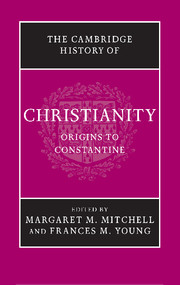Book contents
- Frontmatter
- Prelude: Jesus Christ, foundation of Christianity
- Part I The Political, Social and Religious Setting
- Part II The Jesus Movements
- Part III Community Traditions and Self-Definition
- Part IV Regional Varieties of Christianity in the First Three Centuries
- Part V The Shaping of Christian Theology
- 23 Institutions in the pre-Constantinian ecclēsia
- 24 Monotheism and creation
- 25 Monotheism and Christology
- 26 Ecclesiology forged in the wake of persecution
- 27 Towards a Christian paideia
- Part VI ‘Aliens’ become Citizens: towards Imperial Patronage
- Conclusion: retrospect and prospect
- Bibliographies
- Index
- Map 1. The Roman Empire in the time of Marcus Aurelius
- References
23 - Institutions in the pre-Constantinian ecclēsia
from Part V - The Shaping of Christian Theology
Published online by Cambridge University Press: 28 March 2008
- Frontmatter
- Prelude: Jesus Christ, foundation of Christianity
- Part I The Political, Social and Religious Setting
- Part II The Jesus Movements
- Part III Community Traditions and Self-Definition
- Part IV Regional Varieties of Christianity in the First Three Centuries
- Part V The Shaping of Christian Theology
- 23 Institutions in the pre-Constantinian ecclēsia
- 24 Monotheism and creation
- 25 Monotheism and Christology
- 26 Ecclesiology forged in the wake of persecution
- 27 Towards a Christian paideia
- Part VI ‘Aliens’ become Citizens: towards Imperial Patronage
- Conclusion: retrospect and prospect
- Bibliographies
- Index
- Map 1. The Roman Empire in the time of Marcus Aurelius
- References
Summary
By the time of Constantine the church was a sufficiently robust organization for the emperor to engage it as a partner in unifying the empire. Systems of authority, patterns of belief and control of funds and property had turned the early household communities into an interlinked, empire-wide organization that increasingly mirrored the structure of the empire itself. It is a telling fact that when Julian the Apostate tried to put the clock back in the 360s, he ‘determined to introduce into the pagan temples the order and discipline of Christianity’: various degrees of ministry were instituted, teachers and readers were appointed to give instruction in pagan doctrines, hours of prayer were established, and monasteries founded for those who wanted to live in philosophical retirement; pagan priests were told to provide hospitality for travellers, to distribute corn and wine to the poor and to live holy lives, avoiding taverns and the theatre, or be deprived of office. Julian saw the discipline and benevolence of the ‘atheists’ as attractions dangerous to traditional religion, whereas Constantine had recognised their usefulness.
The characteristics of the early house-based communities were described in part II, chapter 7, above. There, the discussion attempted to view the phenomenon of the early church in its social and historical setting, noting how it combined features of household, cult, club and philosophical school, without being altogether like any of them. Throughout this volume the diversity of Christian groups has been observed: there was a range of possible futures.
- Type
- Chapter
- Information
- The Cambridge History of Christianity , pp. 413 - 433Publisher: Cambridge University PressPrint publication year: 2006
References
- 2
- Cited by

